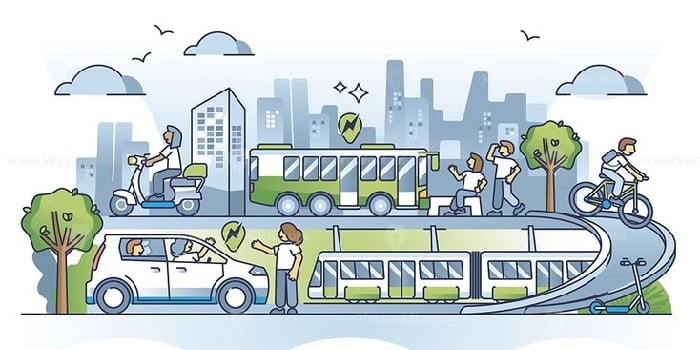Building a connected EV charging ecosystem for municipalities

It’s not enough to simply install EV charging stations around your municipality. Cities must now take a holistic approach to creating entire charging ecosystems rather than one-off stations.
Today, there are 44,700 DC fast chargers and regular chargers in the U.S. and Canada. But even by adding 30,000 more plugs, the United States still requires a far more extensive network.
With the right tools, you can become a part of the solution by implementing EV charging ecosystems for your North American municipality.
What is a connected EV charging ecosystem?
An EV charging ecosystem refers to the hardware, software, people, and organizations involved in creating EV infrastructure. Rather than building EV solutions in a siloed structure, an ecosystem combines multiple components into a complementary system. The goal is to create a flywheel of efficiency and increase sustainability for your organization.
The elements of a good charging ecosystem include:
- Hardware, such as cars, charging stations, and adapters
- Software, such as telematics, EV charging management software, and mobile apps
- People, such as EV drivers, procurement officers, and fleet managers
- Organizations, such as utility companies, government organizations, and charging point operators
Building an effective municipal EV charging ecosystem requires all pieces of this puzzle to work together seamlessly. That’s why you need to begin the planning process early, with sustainable design tips and a conscientious approach.
Design tips for municipal EV charging ecosystems
Constructing an efficient charging ecosystem begins with proper planning and execution. Here’s how you can build a holistic EV charging ecosystem designed to power the city of the future.
1. Start with the backbone
It all begins with effective communication between your organization and its audiences. Before writing any plans or setting initiatives in stone, you may want to start by:
- Communicating with stakeholders
- Chatting with infrastructure providers
- Sharing ideas with utility companies
2. Choose between connected and unconnected networks
There are two different types of EV ecosystems: connected networks and unconnected networks.
Connected networks are incorporated into a central backend system (sometimes called “smart” charging infrastructure). This means they can:
- Connect to your invoice system
- Identify users and invoice appropriately
- Troubleshoot and monitor uptime from afar
Unconnected networks are not connected to any backend IT system (which is why they’re referred to as “dumb” charging stations). Although they don’t share the benefits of connected networks, they are:
- Free of charge for the public
- Cheaper to purchase up front
- Easier to install (does not require intricate networking)
3. Select the EV charging infrastructure mix
Your organization needs to select the right type(s) of charging stations to accommodate its increasing number of EVs. The higher a station’s level is, the faster it can charge vehicles—though keep in mind that this increased efficiency also comes with an increased price.
You can think of your charging stations as a pyramid chart, with:
- Many level one chargers on the bottom
- Several level two chargers in the middle
- Few level three (DC fast) chargers on top
Experts suggest aiming for one basic charger per ten EVs and one DC fast charger per 100 EVs.
4. Pick effective areas to install your charging infrastructure
Like real estate, the effectiveness of your EV charging ecosystem is all about location. You may want to aim for higher-traffic areas that are more accommodating to the public and your fleet.
This includes evaluating areas like:
- Motorways
- Shopping centers
- Cafés
- Restaurants
- Workplaces
- Dense residential zones
- City centers
- Government administration buildings
You may also want to require new buildings and facilities to follow certain EV regulations, such as:
- Making all new buildings EV ready
- Dedicating at least 10% of parking areas to EVs
- Establishing smart chargers to capture real-time data and track energy consumption
5. Consider proper design for your EV ecosystem
Your EV ecosystem isn’t just another utility. Instead, it’s a brandable, public-facing element of your organization. You must design your ecosystem in a way that accommodates your audience and more heavily emphasizes:
- Strong colors
- Bright lights
- Organized cables
- Posted instructions
- Accessible design
- Safe construction
- Weather protection
- Recreation and relaxation
6. Balance your cost and revenue streams
EV infrastructure both requires and generates a large amount of money. To avoid complications or misalignment in the future, you may want to consider how these values add up over time.
For costs, be sure to evaluate:
- Fixed costs (such as construction)
- Variable costs (such as maintenance)
You must also evaluate revenue sources, such as:
- Price per charge
- Utilization
- Amenities and commodities
Don’t forget to seek grant funding if you need help covering costs in the beginning.
Bringing it all together with Sourcewell cooperative contracts
Building a connected EV charging ecosystem requires a real deal of time and effort. However, the cost, stress, and effort of pushing forward are more than worth the initial inconvenience.
A project should always begin with a survey of potential cooperative contracts. Not only can you prepare your city for the future, but you can also align your citizens to upcoming greening initiatives.
Fortunately, getting started is simple, easy, and straightforward. All you need to do is network with the team at Sourcewell to find competitively solicited cooperative contracts for your charging ecosystem.
Sourcewell awards contracts in electric vehicle supply equipment. These contracts assure that government entities can take the first step in creating the infrastructure to support green initiatives. See how Sourcewell can save you time and money while getting the fleet equipment that you need already on contract.


